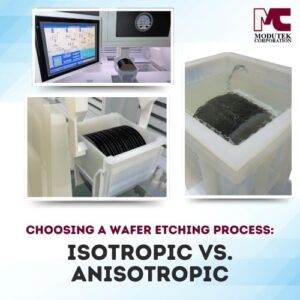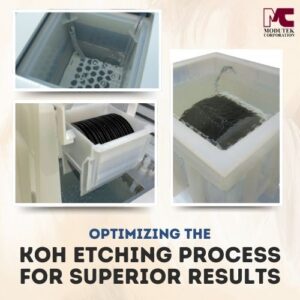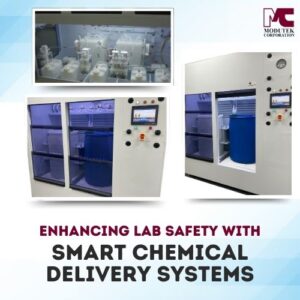![]() The silicon nitride wet etching process is difficult to control safely but is a key component of semiconductor wafer manufacturing. The process uses phosphoric acid to remove silicon nitride masks from silicon wafers to allow the clean wafers to undergo further fabrication steps. The hot phosphoric acid and water mixture is unstable and requires periodic addition of small quantities of water, but adding water to phosphoric acid may produce a bump. Modutek has developed a new approach to control the nitride etching process safely and accurately while achieving high etching rates.
The silicon nitride wet etching process is difficult to control safely but is a key component of semiconductor wafer manufacturing. The process uses phosphoric acid to remove silicon nitride masks from silicon wafers to allow the clean wafers to undergo further fabrication steps. The hot phosphoric acid and water mixture is unstable and requires periodic addition of small quantities of water, but adding water to phosphoric acid may produce a bump. Modutek has developed a new approach to control the nitride etching process safely and accurately while achieving high etching rates.
How the Silicon Nitride Wet Etching Process Works
The etching of silicon nitride masks with phosphoric acid is optimized at a temperature of 160 degrees centigrade for a mixture of 85 percent acid and 15 percent deionized water. At this temperature, the mixture boils and some water is lost as steam. The lost water has to periodically be replaced, but adding water to phosphoric acid can be dangerous. The water may not immediately mix with the acid, instead forming a film on top of the mixture. If the film suddenly mixes with the acid, introducing a large amount of water into the mixture at once, a bump can result.
In order to optimize etching performance small amounts of water are added periodically which immediately mix with the acid to maintain the temperature at the ideal 160 degrees centigrade. If too much water is added, the temperature of the mixture may drop and the mixture may stop boiling, allowing the water film to form and create a dangerous situation. If too little water is added, the temperature of the mixture will increase and even more water will be lost. Modutek has new equipment provides an innovative control strategy that addresses these issues and delivers excellent etching performance.
Modutek’s Nb Series Silicon Nitride Wet Etching Bath
Modutek’s new Nb series bath provides tight control of the bath temperature while ensuring a safe operation and superior etching of the silicon nitride masks. In addition to the new control strategy, the series Nb baths offer additional safety features that make sure the dangerous condition in which large amounts of water are mixed with hot phosphoric acid is avoided.
In their new silicon nitride wet etching equipment, Modutek uses the acid mixture concentration as a reference value for adding small amounts of deionized water. At normal operation, the bath heater is on and the mixture is always boiling at the normal mixture boiling point of 160 degrees centigrade.
The boiling point of the mixture varies with the concentration. As water is lost and the mixture concentration rises, the boiling point increases as well and the mixture temperature starts to rise above 160 degrees centigrade. This rise triggers the addition of a small amount of deionized water. Since the mixture is always boiling because the heater is always on, the deionized water is immediately mixed in with the boiling acid, the concentration of the acid is reduced and the mixture boiling point decreases back down to 160 degrees centigrade.
To guard against the addition of water when the mixture is not boiling, a thermocouple sensor above the boiling mixture detects the presence of steam and closes the water valve when no steam is present. This additional safety feature ensures that a dangerous water film cannot form even under abnormal conditions such as heather failure.
Modutek has been testing and fine tuning the new system with Nb silicon nitride wet etching baths to customers in manual, semi automated and fully automated wet bench stations. Semiconductor fabrication facilities and research centers using the new equipment have achieved an average etch rate of 65 angstroms per minute while limiting oxide etch as the controls ensure safe operation at a consistent and optimum operating point.




